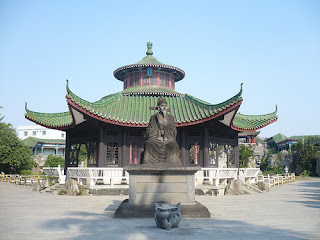Chapter Two
Sanya--China’s Tropical Playground
There is a funny phenomenon in China: when southerners head to China’s frozen northeast to catch the snow sculptures and ice lanterns in the winter, the northern people stream south to Hainan province for Sanya’s sun drenched beaches and luxuriant jungles.--People often describe Sanya as the Hawaii of China where is their ideal tropical playground.
 |
| Sanya Overview |
White sand, blue water and palm trees make Sanya a great destination for sun worshippers. Whether sipping coconut milk as the clean ocean water laps at your feet or floating through a coral jungle, Sanya is the place to go if the words “beach, sun and fun” comes to mind.
While the full 40Km or so of coastline dedicated to tourism is usually referred to as Sanya, the region is actually made up of three distinct zones. Sanya Bay is home to the bustling city center and a long stretch of beach and hotels aimed at locals and mainland holidaymakers. Dadonghai Bay, about 3Km southeast, beyond the Luhuitou Peninsula, is where most Western travelers stay. A further 15Km east, at exclusive Yalong Bay, the beach is first-rate, as is the line of plush international resorts.
The Facts of Sanya
 |
| Sanya Night View |
Sanya’s long history and diversity of inhabitants have helped create colorful folk culture and rural craftworks. With love stories and legends, folk dance and music, statues and parks, Sanya has a lot to offer its visitors.
Sanya in Your Eyes
For most visitors, this city is a noted tourist resort with mountains, sea, river and city. The favorable climate is hot in summer but warm in the three other seasons so attracting large numbers of followers from both home and abroad every year. The whole city is related to the sea. Here you can enjoy a unique tropical oceanic landscape that is totally different from the other provinces of China. Sanya Bay, Dadonghai and Asian Dragon Bay all golden seaboards of Sanya, are some of the first choices for visitors to spend their holidays.
 |
| Beach |
Instead of a busy and exhausting journey, you can relax totally here by strolling along the beaches and breathing the fresh air. If you are an enthusiast of exciting water activities, Wuzhizhou Island is your place to challenge the mysterious and changing sea. Additionally more than 20 ethnic groups including Han, Li, Miao, Hui inhabit there becoming a wonderful place to appreciate the various cultures of China.
Tasting the local dishes is a must on your journey. The city never shirks in its efforts to entertain its guests with a variety of seafood and delicious tropical fruits all the year round. Both of the star-rated hotels and a number of roadside booths serve the freshest seafood. Shopping is also a must on your journey, so don't forget to choose some sea products and beautiful decorations for you or your friends and relatives back home.
Lovers’ Favorite: Tianyahaijiao
 |
| Tianyahaijiao |
Tianyahaijiao consists of Tianya Shopping Village, Tianya Roaming Area, Tianya Gallery, Tianya Ethnic Custom Park and Tianya Remarkable People in History Statues. Nearby, the Fire Platform, Signal Fire Tower, Wanghai Pavilion, Huaisu Pavilion and “A Winding Path Leading to A Secluded Spot” are reachable.
Wuzhizhou-Island of Love
 |
| Wuzhizhou Island |
Colorful & Special Nightlife in Sanya
Apart from the sea, beach and sunshine, the nightlife in Sanya is also a highlight. After a day of exploring cultural sights and shopping malls, you can walk out of your hotel and enjoy the nightlife of Sanya, which can help you relax and introduce you to the other side of Sanya. No matter who you are travelling with, Sanya’s cafes is a good choice. You can have a cup of coffee with your lover or friends while listening to music and watching the tide lap the shore.
 |
| Bar |
If you are looking for more excitement, try some of Sanya’s bars. Times Coast Bar Street is home to various bars and pubs, where you can let you admire the sea, yachts and beach at the same time, and offers a great place for people watching among the fashionable crowds. Cinema and theater lovers are also catered for in Sanya, so whatever you prefer, you can always find nightlife to suit your tastes in Sanya.
All in all, if you are a person who is good at enjoying, Sanya can be a perfect place for you to waste time. Sanya offers so many unique sightseeing and attractions so that visitors are never short of places to see and visit. Enjoy Sanya tours and see sapphire seas, and feel the warm radiance of the sun on your cheeks while a cool rush of ocean water sucks the sand from between your toes. Don’t you think Sanya is your tropical playground and leisure paradise now?












